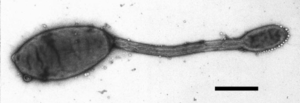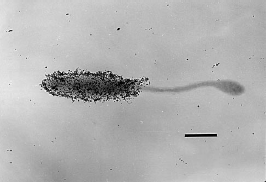Hyphomonas adhaerens: Difference between revisions
| Line 29: | Line 29: | ||
Interesting features of cell structure; how it gains energy; what important molecules it produces. | Interesting features of cell structure; how it gains energy; what important molecules it produces. | ||
==Ecology and Significance to Gold== | ==Ecology, Pathogenenis, and Significance to Gold== | ||
[[Image:MHS-3 gold.png|thumb|300px|right|''Hyphomonas adhaerens'']] | |||
''Hyphomonas adhaerens'' has no known pathogenicity as well as no known symbiotic relationships. | |||
As mentioned above, ''Hyphomonas adhaerens'' (MHS-3) adheres to submerged surfaces in the marine environment, however, it is oftentimes found living adjacent to hydrothermal vents where gold is found in abundance. The solubility of gold decreases as seawater cools and results in the deposition of gold sulfides. Gold is subsequently carried into the water column in a hydrothermal plume then becomes deposited on the seafloor. [2] | As mentioned above, ''Hyphomonas adhaerens'' (MHS-3) adheres to submerged surfaces in the marine environment, however, it is oftentimes found living adjacent to hydrothermal vents where gold is found in abundance. The solubility of gold decreases as seawater cools and results in the deposition of gold sulfides. Gold is subsequently carried into the water column in a hydrothermal plume then becomes deposited on the seafloor. [2] | ||
Revision as of 17:05, 14 April 2013
Classification
Bacteria; Proteobacteria; Alphaproteobacteria; Rhodobacterales; Hyphomonadaceae; Hyphomonas
Species
|
NCBI: Taxonomy |
Hyphomonas adhaerens
Description and Significance
adhaerens means "hanging on/sticking to."
Hyphomonas adhaerens is a marine, budding/prosthecate bacteria. It is a primary colonizer on submerged surfaces in the marine environment. The main body of the mother cell is a prolate spheroid, 1-2 μm in diameter with one prosthecum 0-2 μm wide x 1-5 μm long. It is motile by a single flagellum and the main body of the reproductive cell is surrounded by a capsular polysaccharide. It is gram-negative, not acid-fast, has no endospores, and is aerobic. Forms in colonies that are round and undulate and are 1-5 mm in diameter after three days at 30°C. Forms a thick biofilm in liquid media and grows optimally at 27-37°C. Optimum growth in ocean salt is 1.5-12% and pH at 5.7-8.7. It also reduces nitrate. [1]
Genome Structure
Describe the size and content of the genome. How many chromosomes? Circular or linear? Other interesting features? What is known about its sequence?
The G+C content of Hyphomonas adhaerens is 60%.
Cell Structure, Metabolism and Life Cycle
Interesting features of cell structure; how it gains energy; what important molecules it produces.
Ecology, Pathogenenis, and Significance to Gold
Hyphomonas adhaerens has no known pathogenicity as well as no known symbiotic relationships.
As mentioned above, Hyphomonas adhaerens (MHS-3) adheres to submerged surfaces in the marine environment, however, it is oftentimes found living adjacent to hydrothermal vents where gold is found in abundance. The solubility of gold decreases as seawater cools and results in the deposition of gold sulfides. Gold is subsequently carried into the water column in a hydrothermal plume then becomes deposited on the seafloor. [2]
MHS-3 interestingly has the ability to bind gold. On average, it comprised an average of 58.2+/-2.27% wt/wt gold when incubated in a 2.5-mM solution of chloroauric acid. MHS-3 EPS has the ability to sequester cationic gold because the EPS is negatively charged while the metal ions are positively charged. Colloidal gold adheres to the polar polysaccharide capsule of MHS-3 and not to the capsuleless MHS-3 rad cells. [2]
References
Author
Page authored by Jeremy Hamer and Nicole Sanchez, students of Prof. Jay Lennon at Michigan State University.


